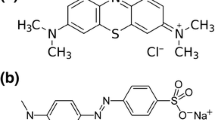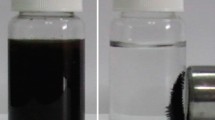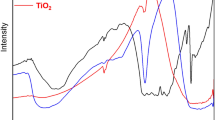Abstract
Sol–gel and dip-coating methods were used to prepare the modified nano-TiO2 film electrode; its photocatalytic and electrochemical properties were investigated under both UV light and sunlight for the degradation of Disperse Blue. The results showed that the effect of co-doping metal and non-metal ions was better than that of single metal ion doping or no doping. Y–F co-doping could better take advantage of sunlight so as to decrease the energy gap of semiconductor and to improve the utilization of visible light, while Ce–F co-doping served to separate photo-generated h +/e − pairs, which resulted in better degradation of dye under UV light. The grain size of prepared electrode was from 15 to 25 nm, and nano particles were arranged smoothly as well as closely with each other, confirming to be an effective binder. The final decolorization extents reached 44.43% under sunlight and 96.86% under UV light within 30 min, respectively.





























Similar content being viewed by others
References
Shi YH, Meng HM, Sun Dongbai YuHY, Wang XD (2007) Progress of Ti based base metal oxide coating anode. J Funct Mater 38:2696–2699
P HQ, Xu K (2003) Current status and prospect of printing & dyeing waste-water treatment. Sichuan Textile Technology 2:11–14
Meng NC, Bo J, Christopher WK, Chris S (2010) Recent developments in photocatalytic water treatment technology: a review. Water Res 44:2997–3027
Fujishima A, Honda K (1972) Electrochemical photolysis of water at a semiconductor electrode. Nature 238:37–38
Yang HM, Zhang K, Shi RR, Li XW, Dong XD, Yu YM (2006) Sol–gel synthesis of TiO2 nanoparticles and photocatalytic degradation of methyl orange in aqueous TiO2 suspensions. J Alloys Compd 413:302–306
Uzunova M, Kostadinov M, Georgieva J, Dushkin C, Todorovsky D, Philippidis PI, Sotiropoulos S (2007) Photoelectrochemical characterisation and photocatalytic activity of composite La2O3–TiO2 coatings on stainless steel. Appl Catal B-Environ 73:23–33
Marta M, William B, Colussi AJ, Michael R, Hoffmann (2004) Oxidative power of nitrogen-doped TiO2 photocatalysts under visible illumination. J Phys Chem B 108:17269–17273
Michael R, Hoffmann STM, Choi WY, Detlef WB (1994) The role of metal ion dopants in quantum-sized TiO2: correlation between photoreactivity and charge carrier recombination dynamics. J Phys Chem 98:13669–13679
Riassetto D, Holtzinger C, Messaoud M (2009) Mechanisms involved in the platinization of sol–gel-derived TiO2 thin films. J Photoch Photobio A 202:214–220
Félix G, Ricardo G, Manuel A (2008) Photodegradation of the herbicide 2,4-dichlorophenoxyacetic. J Mol Catal A-Chem 281:119–125
Archanakar YRS, Caidyanathan S (2009) Improved photocatalytic degradation of textile dye using titanium dioxide nanotubes formed over titanium wires. Environ Sci Technol 43:3260–3265
Chen QF, Jiang D, Xu Y (2009) Visible region photocatalysis of Ce–Si/TiO2 synthesized using sol–gel hydrothermal method. Acta Phys- Chim Sin 25:617–623
Romero DC, Torres GT, Arévalo JC (2010) Synthesis and characterization of TiO2 doping with rare earths by sol–gel method: photocatalytic activity for phenol degradation. J Sol–Gel. Part Sci Technol 56:219–226
Jian ZC, Pu YY, Fang JZ (2010) Microemulsion synthesis of nanosized TiO2 particles doping with rare-earth and their photocatalytic activity. Photochem Photobio 86:1016–1021
Arconada N, Durán A, Suárez S, Portela R, Coronado JM, Sánchez B, Castro Y (2008) Synthesis and photocatalytic properties of dense and porous TiO2-anatase thin films prepared by sol–gel. Appl Catal B-Environ 86:1–7
Wang XW, Gang L, Chen ZG, Li F, Wang LZ, Lu GQ, Cheng HM (2009) Enhanced photocatalytic hydrogen evolution by prolonging the lifetime of carriers in ZnO/CdS heterostructures. Chem Commun 23:3452–3454
Jin W, Nyago TD, James L (2009) Origin of photocatalytic activity of nitrogen-doped TiO2 nanobelts. J Am Chem Soc 131:12290–12297
Malato S, Fernandez-Ibanez P, Maldonado MI, Blanco J, Gernjak W (2009) Decontamination and disinfection of water by solar photocatalysis: recent overview and trends. Catal Today 147:1–59
Wu S, Yu T, Zhang Y (2009) Preparation of mixed rare earth doped Ti/TiO2 electrode and its evaluation. Sci Technol Dev 40:106–107
Li MC, Shen JN (2006) Photoelectrochemical oxidation behavior of organic substances on TiO2 thin-film electrodes. J Solid State Electr 10:980–986
Xiao SH, Qu JH, Liu HJ, Zhao X, Wan DJ (2009) Fabrication of TiO2/Ti nanotube electrode and the photoelectrochemical behaviors in NaCl solutions. J Solid State Electr 13:1959–1964
Devi LG, Kottam N, Murthy BN (2010) Enhanced photocatalytic activity of transition metal ions Mn2+, Ni2+ and Zn2+ doped polycrystalline titania for the degradation of Aniline Blue under UV/solar light. J Mol Catal A-Chem 328:44–52
Khan R, Kin SW, Kin TJ et al (2008) Comparative study of the photocatalytic performance of boron-iron co-doped and boron-doped TiO2 nanoparticles. Mater Chem Phys 112:167–172
Zhang HR, Tan KQ, Zheng HW (2011) Preparation, characterization and photocatalytic activity of TiO2 codoped with yttrium and nitrogen. Mater Chem Phys 125:156–160
Adel AI (2005) Synthesis and characterization of Y2O3–Fe2O3–TiO2 nanoparticles by sol–gel method. Appl Catal B-Environ 58:115–121
Zhang XC, Yang HM, Tang AD (2008) Optical, electrochemical and hydrophilic properties of Y2O3 doped TiO2 nanocomposite films. J Phys Chem B 112:16271–16279
Karunakaran C, Abiramasundari G, Gomathisankar P (2010) Cu-doped TiO2 nanoparticles for photocatalytic disinfection of bacteria under visible light. J Colloid Interf Sci 352:68–74
Huang LF, Song N, Yao Y (2009) Progress in research of doping modification of nano-sized TiO2 photocatalyst. Titanium Ind Process 26:22–25
Long R, English NJ (2009) Synergistic effects of Bi/S codoping on visible light-activated anatase TiO2 photocatalysts from first principles. J Phys Chem C 113:8373–8377
Xu KJ, Zhu GQ (2009) Preparation and characterization of nano-La (S, C)-TiO2 oriented films by template hydrothermal synthesis. Appl Surf Sci 255:6691–6695
Wang P, Liu ZR, Lin F (2010) Optimizing photoelectrochemical properties of TiO2 by chemical codoping. Phys Rev A 82:1–4
Huang DG, Liao SJ, Liu JM (2006) Preparation of visible-light responsive N-F-codoped TiO2 photocatalyst by a sol–gel-solvothermal method. J Photochem Photobio A-Chem 184:282–288
Montoya JF, Salvador P (2007) The influence of surface fluorination in the photocatalytic behaviour of TiO2 aqueous dispersions-An analysis in the light of the direct–indirect kinetic model. Appl Catal B-Environ 94:97–107
Giannakopoulou T, Todorova N, Vaimakis T (2008) Study of fluorine-doped TiO2 sol–gel thin coatings. J Sol Energy Eng 130:1–5
Yu CL, Zhou WQ, Yang K (2010) Hydrothermal synthesis of hemisphere-like F-doped anatase TiO2 with visible light photocatalytic activity. J Mater Sci 45:5756–5761
Pelaez M, Cruz AA, Stathatos E (2009) Visible light-activated N-F-codoped TiO2 nanoparticles for the photocatalytic degradation of microcystin-LR in water. Catal Today 144:19–25
Acknowledgements
This work was supported by the Natural Science Foundation of Shanghai (No. 10ZR1432500) and Central Laboratory of Department of Chemistry and School of Life Science and Technology at Tongji University.
Author information
Authors and Affiliations
Corresponding author
Rights and permissions
About this article
Cite this article
Tang, W., Wang, Q., Zeng, X. et al. Photocatalytic degradation on Disperse Blue with modified nano-TiO2 film electrode. J Solid State Electrochem 16, 1429–1445 (2012). https://doi.org/10.1007/s10008-011-1540-3
Received:
Revised:
Accepted:
Published:
Issue Date:
DOI: https://doi.org/10.1007/s10008-011-1540-3




